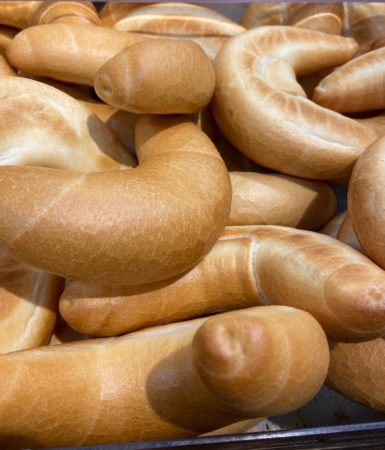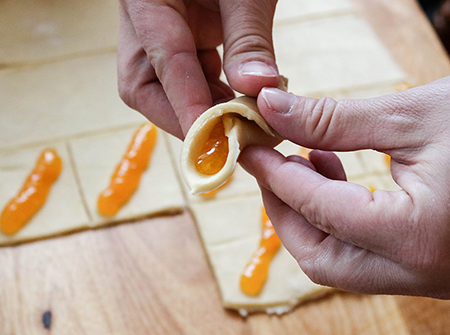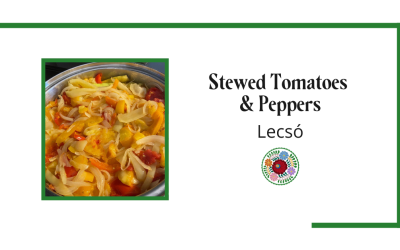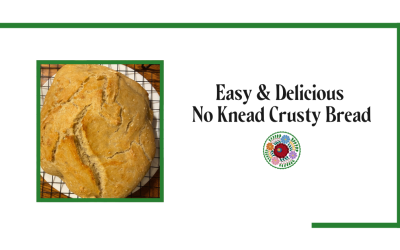Let’s talk about Kifli!
But to set the stage for this discussion, let’s talk about the game Telephone! If you have ever played this game, you know that someone starts it off by one person whispering a sentence very quietly to the person next to them and then that person restates the sentence to the next person and it goes on down the line. Often, what is heard is not at all like to initial statement. We know how distorted things can become during a 10 minute game.
 Now apply this to how people refer to the names of Hungarian food — particularly if their families came to the USA in the late 1800’s and early 1900’s. That is a lot of generations of passing down words, often with no physical spelling for reference! It is so easy to see where words, both in pronunciation and spelling, have been compromised! Most of my family came to the USA over 100 years ago and, depending on the region they were from, words were different. So, if you are inclined to be intolerant and unforgiving when it comes to pronunciation and spelling errors when it comes to Hungarian, take a deep breath. Celebrate that there are people striving to pass down Hungarian food traditions!
Now apply this to how people refer to the names of Hungarian food — particularly if their families came to the USA in the late 1800’s and early 1900’s. That is a lot of generations of passing down words, often with no physical spelling for reference! It is so easy to see where words, both in pronunciation and spelling, have been compromised! Most of my family came to the USA over 100 years ago and, depending on the region they were from, words were different. So, if you are inclined to be intolerant and unforgiving when it comes to pronunciation and spelling errors when it comes to Hungarian, take a deep breath. Celebrate that there are people striving to pass down Hungarian food traditions!
The delicious yeast rolls pictured above are known as kifli all over Hungary. Their aroma and taste are wonderful. But they are not a sweet item. They are similar in shape to the croissant, but with a different dough. The idea behind the word “kifli” has to do with the shape of the item. Recipe for the KIFLI picture above.
But as I was growing up, we referred to these sweet little treats pictured on the left as kifli. In fact, many people in the USA with Hungarian heritage have called these types of cookies kifli, kiffles,  kipfel, kolatchy, crescent cookies, and even the very basic, Hungarian cookie. In the end, these all taste pretty similar. The fillings are often a thick jam of apricot, prune, raspberry, walnut, poppyseed, or farmer cheese filling. But the key to using the word “kifli” has to do with its shape. Is it crescent shaped? Then it can be called kifli. Is it open ended where the filling peeks through? Then it is called papucs.
kipfel, kolatchy, crescent cookies, and even the very basic, Hungarian cookie. In the end, these all taste pretty similar. The fillings are often a thick jam of apricot, prune, raspberry, walnut, poppyseed, or farmer cheese filling. But the key to using the word “kifli” has to do with its shape. Is it crescent shaped? Then it can be called kifli. Is it open ended where the filling peeks through? Then it is called papucs.
Papucs means “slipper” in Hungarian. I do love saying the word papucs so, for that reason alone, I have started calling these papucs in our family. Pa’pooch is the way you might say it phonetically, with the emphasis on the first syllable. The recipe for papucs and the sweet version of kifli is similar. CLICK HERE! (I fixed the link!)
To add to the confusion, there are other variations of kifli! When visiting a little bakery in Hungary, you might see tiny, bite sized hókifli, which are tiny kifli dunked in powdered sugar. Hó is the word for snow in Hungarian. And, don’t forget about Pozsonyi Kifli, named after the city of Pozsony, now known as Bratislava in Slovakia. They are a bit different — a larger crescent but with walnut or poppy seed filling inside. There are also Half Moon Cakes also known as Kossuth Kifli — here is a recipe for those!
Do you have other names you use to describe the cookies above?
We love helping people discover, celebrate, and share Hungarian heritage! Our newsletters are full of great information relating to Hungarian heritage and Hungarians in the USA — CLICK HERE to sign up!
Looking for meaningful Hungarian gifts? Check out The Hungarian Store




